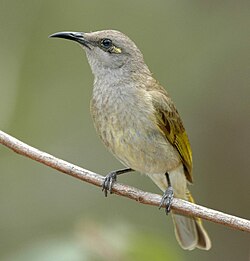| Lichmera | |
|---|---|
 | |
| Brown honeyeater (Lichmera indistincta) | |
| Scientific classification | |
| Kingdom: | Animalia |
| Phylum: | Chordata |
| Class: | Aves |
| Order: | Passeriformes |
| Family: | Meliphagidae |
| Genus: | Lichmera Cabanis, 1851 |
| Type species | |
| Glyciphila ocularis [1] Gould, 1838 | |
| Species | |
See text | |
Lichmera is a genus of birds in the honeyeater family Meliphagidae that are found in Southeast Asia.
